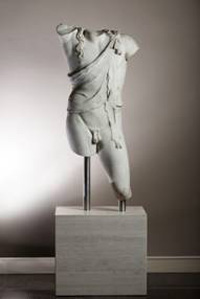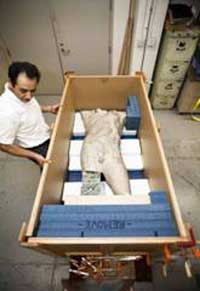
 Sculpture News at SculptSite.com
Sculpture News at SculptSite.com
Santa Barbara Museum of Art - Dionysus Sculpture |
 Dionysus |
edhat Santa BarbaraDionysus is Now on View at the Santa Barbara Museum of ArtTransporting, conserving, and cleaning a 900-pound, over life-size fragment of marble Roman statue dating from around 100 -150 CE can be a daunting process but can also render glorious results. After months of careful planning and conservation assistance from neighboring J. Paul Getty Museum's Antiquities Conservation Department, the Lansdowne Dionysus is newly-installed in the Santa Barbara Museum of Art's Ludington Court. In 2009, the Museum acquired two significant works of art that were originally part of the collection of Wright S. Ludington, one of SBMA's founders and patrons. The works included a Roman sarcophagus of the 1st or 2nd century CE, and a large fragment of a monumental marble statue dating from about the 2nd century CE. These joined the important group of antiquities that Ludington had given to the Museum years earlier. The sarcophagus was in good enough condition to be put on view, but the statue fragment had been displayed outdoors for many years and had suffered the effects of the environment. Identified through its "attributes" (an animal skin and a chiton, traces of which are discernible on the piece) as a representation of Dionysus, the god of wine, the sculpture was conserved by Elizabeth ("Liz") Chayes at the Getty Villa in Malibu, CA, overseen by Jerry Podany, Senior Conservator of Antiquities at J. Paul Getty Museum. According to Chayes, there are many challenges in conserving a stone sculpture that has been exposed to an uncontrolled, outdoor environment. Aside from temperature fluctuations, dirt accumulation, and moisture, there are microorganisms, algae, and lichen that can deteriorate and discolor the stone. After a careful and systematic cleaning of the marble, the piece was stabilized to improve its structural integrity, as the original stand it had been mounted on created pressure on the marble and an increased propensity for fracture. Cheyes also had to contend with the fact that the Lansdowne Dionysus has been restored numerous times in the past, sometimes almost beyond recognition. The Dionysus sculpture was originally lifted from a bog along with more than 70 individual works of ancient sculpture at Hadrian's Villa in Tivoli in the mid-18th century. Constructed around 120 CE, the Villa had been lavishly decorated inside and out with some of the greatest Roman works of all time, most based on Greek originals. The systematic excavations at the site sparked a flourish of antiquarian, architectural, and artistic study of the spectacular buildings, and sculptures that were being unearthed. Some of the other marbles from that bog are now housed in other prestigious museum collections, including the Capitoline Museums (Harpocrates, Furietti Centaurs and Faun in Red Marble), the Louvre (Diana of Versailles), and the Vatican Museums. http://blog.sbma.net/wp-content/uploads/2011/01/Previous-Restoration-from-Cavaceppis-Raccolta-Dantiche-1768-241x500.jpgWhen the Dionysus torso was excavated, it came into the hands of Bartolomeo Cavaceppi (1716-1799), a sculptor who ran a large workshop in Rome restoring ancient marble sculptures. Cavaceppi's records show that the torso received a new head, arms, legs, and a support consisting of a tree trunk entwined with grapevines (see illustration) to satisfy the taste of the day for whole statues, rather than archaeological fragments. The restored Dionysus was then sold to the first Marquis of Lansdowne (1737-1805), a British politician and art collector who amassed a spectacular collection of ancient marble sculpture to decorate his house in London, England. In 1930, when Lansdowne's descendants put his sculptures up for auction, the Lansdowne Dionysus was purchased by Wright S. Ludington. The statue was brought to California, the 18th-century restorations were removed, and the remaining ancient torso was installed in the gardens of Ludington's Val Verde estate in Montecito?until 70 years later, when SBMA was able to acquire it. Ludington donated hundreds of works to SBMA, ranging from antiquity to the 20th century and including the magnificent Lansdowne Hermes, which has graced the Museum's Ludington Court since 1998. Now, the prestigious and renewed Lansdowne Dionysus joins its counterpart for the public to admire. |
 "Time, time , time see what's become of me" evidently not too much considering the time-lapse on this sculpture/statue. Time and Sculpture, so intertwined, so very, very important to us all... |
 Lansdowne Dionysus being prepared to travel to the Getty Villa for conservation. |
Sounds of Sculpture ....
Hazy Shade of Winter originally a huge classic hit for Simon & Garfunkel. This sculpture and time just tripped the words of this song for me. Here is a remake of the same tune by the Bangles - Enjoy!
Submit your SCULPTURE NEWS.
It's easy, just send us an e-mail
(click on Submit News in the left menu) with your pertinent information along with images, we'll take care of the rest. Sculpture makes our world a much better place in so many ways!
SculptSite.com, along with Sculptors and their creative genius all helping to bring the beauty and message of Sculpture to a hurried world.

